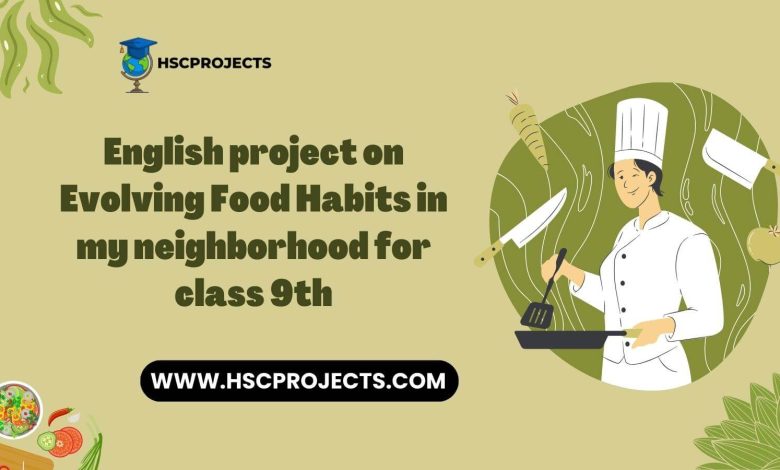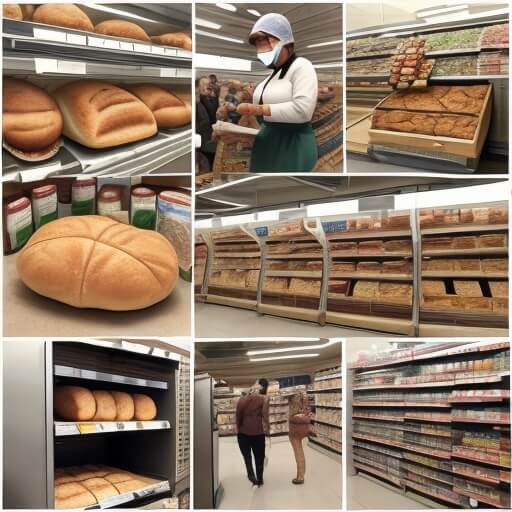
English Project On Evolving Food Habits In My Neighborhood For Class 9th
Introduction:
Food transcends mere sustenance; it mirrors the intricate dance of culture, lifestyle, and societal shifts. In our beloved neighborhood, it’s a microcosm of this intricate interplay, where food habits have unfurled their tapestry through time, sculpted by historical traditions, global dynamics, and the contours of our daily lives. This endeavor embarks on a voyage through the dynamic realm of evolving food culture in our neighborhood, a journey that unravels the transformation of our diets, particularly against the backdrop of the unique circumstances wrought by the COVID-19 pandemic.
Objectives
- To delve into the historical food traditions of our neighborhood.
- To scrutinize the driving forces behind shifting food habits.
- To document contemporary food preferences and dietary choices.
- To analyze the influence of globalization on local cuisine.
- To evaluate the sustainability of evolving food practices.
- To propose recommendations for preserving and promoting our local food culture.
Action Plan for the Project
Research: Immerse ourselves in the annals of our neighborhood’s culinary history through extensive reading, perusing articles, and engaging in enlightening interviews.
Interviews: Forge a questionnaire (see below) and engage in insightful conversations with our neighbors.
Observations: Discern the interplay between local and international culinary offerings within our vicinity.
Data Analysis: Dissect the amassed data to unveil patterns and transitions in food consumption.
Report: Compile our findings into a comprehensive report, encapsulating the culinary evolution of our neighborhood.
Recommendations: Proffer pragmatic strategies to nurture and propagate our cherished local food culture.
Questionnaire for Interviews
- How has your family’s culinary heritage evolved over time?
- Which timeless dishes or recipes have been treasured through generations in your family?
- Have there been recent additions to your gastronomic repertoire, and what spurred those choices?
- In what ways do you perceive globalization impacting your dietary preferences?
- Are there specific events or festivals that wield influence over your culinary inclinations?
- To what extent does supporting local food producers and markets resonate with you?
- Have you detected sustainability practices entwined with your dietary selections?
A Report on Shifting Food Practices in Our Neighborhood:
In our neighborhood, food has eternally occupied a special place in our hearts and homes. The culinary traditions passed down from ancestors have not only etched our identity but have also served as a comforting thread that binds us. Yet, as our world has drawn ever closer together, we’ve witnessed a gradual metamorphosis in our dietary preferences. Globalization has ushered in exotic flavors to tantalize our palates, conveniently delivered to our doorstep. The brisk pace of modern life has also shaped the way we prepare and consume our meals, with fast food and convenience options gaining prominence.
Amidst these transformations, our neighborhood faced a distinct challenge in the form of the COVID-19 pandemic and the ensuing lockdowns. These extraordinary circumstances compelled us to reconsider our culinary choices. As restaurants shuttered and certain ingredients became scarce, our kitchens beckoned, and we embarked on a journey of culinary rediscovery. Home-cooked meals experienced a renaissance, and we found solace in traditional recipes, embracing healthier eating habits. We bore witness to the resurgence of local and organic produce as we sought to support our community and fortify our well-being.
Impact of the COVID-19 Lockdown on Dietary Preferences:

The lockdowns imposed during the COVID-19 outbreak disrupted our routines, forcing us to adapt to a new way of life. As eateries closed and certain ingredients became scarce, we turned to our kitchens to satisfy our culinary desires. This period of isolation prompted many of us to experiment with cooking and baking, leading to a renaissance of homemade meals. The importance of nutrition and health gained prominence as we became acutely aware of the value of a robust immune system.
Dietary Preferences of Adolescents:

Adolescents in our neighborhood navigate a culinary landscape that harmonizes tradition with modernity. While fast food and snacks hold allure, they are increasingly exposed to health-conscious choices, venturing into the realms of vegetarian and vegan options. The sway of peer groups and the influence of social media wield substantial power in shaping their food preferences, underscoring the need for nutritional education and mindful eating.
Dietary Habits of the Working Class:

The working class in our neighborhood grapples with the challenge of balancing time constraints with nutritional needs. Busy schedules often result in reliance on convenience foods, which may not always align with the healthiest choices. Nevertheless, some have adopted strategies like meal prepping and opting for healthier takeout options to ensure that they maintain a balanced diet, even amidst their hectic lives.
Dietary Choices of Older Residents:

For the elderly population in our neighborhood, dietary choices are steeped in tradition. Many cherish home-cooked meals that evoke memories of their youth, placing comfort and familiarity above novelty. Nonetheless, there is a growing awareness of the importance of dietary diversity and nutritional requirements in the later stages of life. This has sparked interest in adapting their diets to better align with their health needs.
Conclusion:
As we draw the curtains on our exploration of evolving food habits, we are left with a profound realization that food is not just sustenance; it’s a reflection of our evolving society. By embracing diversity and balance in our diets, and by preserving the essence of our culinary traditions, we can ensure that our neighborhood thrives as a vibrant and resilient community. Nourished by the richness of our heritage and the promise of a healthier future, we can continue to savor the flavors of our evolving culinary journey.
Certificate of Completion
[Student’s Name][Class/Grade Level]This is to certify that I, [Student’s Name], a [Class/Grade Level] student, have successfully completed the project on “Evolving Food Habits In My Neighborhood For Class 9th.” The project explores the fundamental principles and key aspects of the chosen topic, providing a comprehensive understanding of its significance and implications.
In this project, I delved into in-depth research and analysis, investigating various facets and relevant theories related to the chosen topic. I demonstrated dedication, diligence, and a high level of sincerity throughout the project’s completion.
Key Achievements:
Thoroughly researched and analyzed English Project On Evolving Food Habits In My Neighborhood For Class 9th.
Examined the historical background and evolution of the subject matter.
Explored the contributions of notable figures in the field.
Investigated the key theories and principles associated with the topic.
Discussed practical applications and real-world implications.
Considered critical viewpoints and alternative theories, fostering a well-rounded understanding.
This project has significantly enhanced my knowledge and critical thinking skills in the chosen field of study. It reflects my commitment to academic excellence and the pursuit of knowledge.
Date: [Date of Completion]Signature: [Your Signature] [School/Institution Name][Teacher’s/Examiner’s Name and Signature]
In order to download the PDF, You must follow on Youtube. Once done, Click on Submit
Subscribed? Click on Confirm
Download English Project On Evolving Food Habits In My Neighborhood For Class 9th PDF






